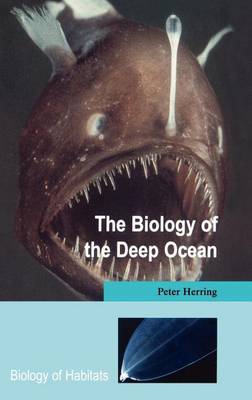Biology of Habitats
1 total work
The deep ocean environment is the most extensive on our planet. Its denizens are normally unseen but whenever they are exposed to view they are regarded as bizarre aliens from a different world. The Biology of the Deep Ocean takes a close look at this apparently hostile world and explains how its inhabitants are exquisitely adapted to survive and flourish within it.
The book begins with an analysis of how conditions in the oceanic environment differ from those in the familiar terrestrial world and then describes the techniques (and ingenuity) required to reveal the populations inhabiting the colossal volume of the deep oceans. A section on primary production emphasizes how almost all deep-sea life depends ultimately on the phytoplankton at the surface and the export flux to deeper water. The ultimate beneficiaries of this export, the populations on the
deep-sea floor, are then discussed, together with the unique features of life fuelled by chemosynthesis at hydrothermal vents and cold seeps. The horizontal and vertical distribution patterns of deep-sea animals, and their changes in time and space, are controlled by physical, biological and historical
factors. The rapid reduction of biomass with depth puts a high priority on efficient prey capture and energy conservation. Chapters on energy efficiency, mechanoreception, chemoreception and vision reveal the extraordinary adaptations necessary for success. Accounts of the effector systems involved in colour, camouflage and bioluminescence heighten the concept of a different world. A chapter on animal life styles emphasizes the links between size, sex, and seasonality, visible in the
contrasting benefits of gigantism, dwarf males and the ability to respond to a periodic influx of food from the surface. The final chapter and appendix deal with the unique and exciting variety of life in the deep ocean, formalized as biodiversity. Its different expression on the sea floor and in midwater
invites both comparisons with the rain forest and concerns about its fragility, taking the reader back to the emphasis in the first chapter on how little we still know about this critical habitat.
The Biology of the Deep Ocean complements the two companion volumes on the biology of littoral and estuarine habitats and is designed to be accessible to all marine scientists, student and professional.
The book begins with an analysis of how conditions in the oceanic environment differ from those in the familiar terrestrial world and then describes the techniques (and ingenuity) required to reveal the populations inhabiting the colossal volume of the deep oceans. A section on primary production emphasizes how almost all deep-sea life depends ultimately on the phytoplankton at the surface and the export flux to deeper water. The ultimate beneficiaries of this export, the populations on the
deep-sea floor, are then discussed, together with the unique features of life fuelled by chemosynthesis at hydrothermal vents and cold seeps. The horizontal and vertical distribution patterns of deep-sea animals, and their changes in time and space, are controlled by physical, biological and historical
factors. The rapid reduction of biomass with depth puts a high priority on efficient prey capture and energy conservation. Chapters on energy efficiency, mechanoreception, chemoreception and vision reveal the extraordinary adaptations necessary for success. Accounts of the effector systems involved in colour, camouflage and bioluminescence heighten the concept of a different world. A chapter on animal life styles emphasizes the links between size, sex, and seasonality, visible in the
contrasting benefits of gigantism, dwarf males and the ability to respond to a periodic influx of food from the surface. The final chapter and appendix deal with the unique and exciting variety of life in the deep ocean, formalized as biodiversity. Its different expression on the sea floor and in midwater
invites both comparisons with the rain forest and concerns about its fragility, taking the reader back to the emphasis in the first chapter on how little we still know about this critical habitat.
The Biology of the Deep Ocean complements the two companion volumes on the biology of littoral and estuarine habitats and is designed to be accessible to all marine scientists, student and professional.
